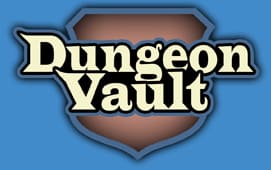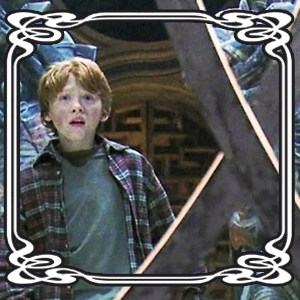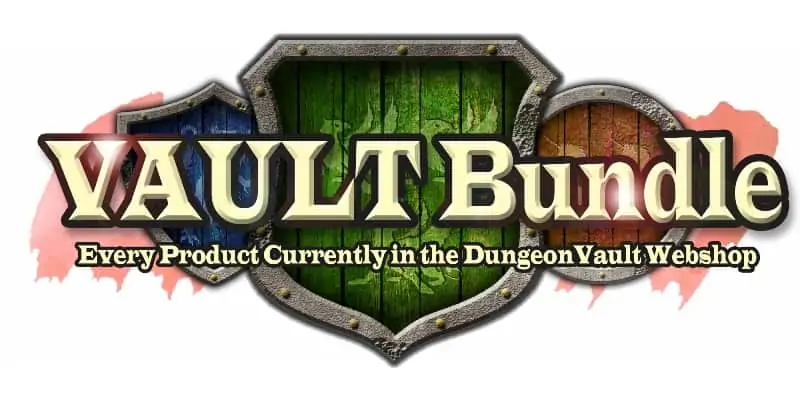
When you introduce puzzles into your Dungeons and Dragons game, you want to make sure your players actually enjoy solving them. Chess puzzles have been popular for hundreds of years, so it stands to reason your players would enjoy them as well. Or do they? I set up a little experiment to test which type of chess puzzles players enjoy the most.
First, I created an adventure which has all types of chess puzzles. Then, I ran the adventure online for two groups and asked them to score each puzzle according to three criteria:
- Enjoyment: How much fun did you have?
- Immersion: Did the puzzle draw you into the game?
- Flow: Did you enjoy the process of discovery?
And the results are in.
3: The Classic Chess Puzzle
The classic chess puzzle is really any setup where players can win the game in either 1, 2, or 3 moves. Of course, puzzles where you can win in one move are the easiest. Here’s an example.
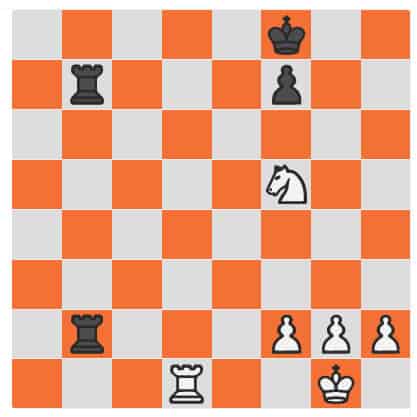
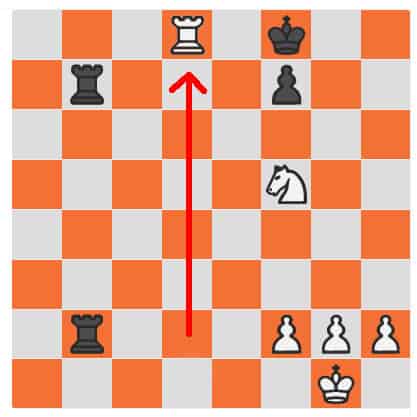
White always moves first so moving the tower upward wins the game. It’s a solid chess puzzle but did my D&D players enjoy it?
My players did not enjoy this puzzle. It doesn’t offer any immersion. It’s just a chess game put into a D&D game. You can do that online with any of the countless chess puzzle generators. And there’s also only one step to solving the puzzle. So it doesn’t invite players to work together and D&D is a cooperative game after all.
- Enjoyment: 2
- Immersion: 0
- Flow: 0
2: The Simple Chess Puzzle
With this puzzle setup the Queen must capture all pawns. She gets as many moves as you wish, but can’t move to an empty square. (A queen can move horizontally, vertically, and diagonally in any direction.)

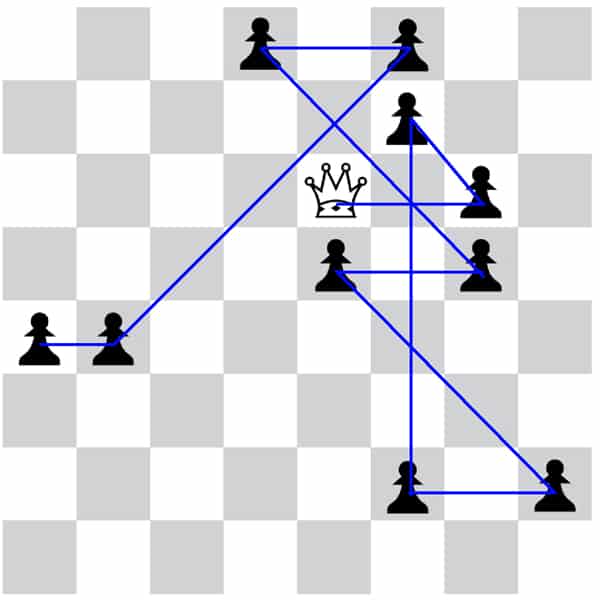
Players liked that this puzzle has more than one move to it. They can discuss how to solve the puzzle and started by mapping out the pieces that can only be connected to two other pieces. There’s also the option to roll the dice for a hint without giving away the whole puzzle. This way you can challenge the characters and have their abilities be relevant.
The simple D&D chess puzzle has good flow, but it still lacks immersion. Just like the previous puzzle it doesn’t feel like a part of the world.
- Enjoyment: 6
- Immersion: 0
- Flow: 8
1: The Halfling Heart D&D Chess Puzzle
This chess puzzle I designed specifically for dungeons and dragons. It’s part of the Floor Puzzles pack which contains several mini-games and 20 unique D&D puzzles. Here’s how it works:
“Light heartedness and agility are values taught by the game Halfling’s Heart. The small must be quick and agile, stepping lightly and lively where others plough through.”
Players are first introduced to a mini-game in a tavern. It’s a very quick game so it doesn’t take away too much time from the overall story. But it does add a bit of flavor to the halfling culture. Also, when players learn the rules to this game, they are also learning the rules to the puzzle which you will introduce later in the story.
- Each player receives three cards. During their turn players play one card. Players can refill their hand to three cards for as long as there are cards in the deck.
- The player that has most recently avoided detection begins the game.
- The first player places a card on a square of the gaming board.
- Signs are similar to chess moves. A heart is like a knight, a shield like a rook, swords like a bishop and a crown like a king.
- Players must place cards in such a manner that – if the chess move corresponding to the placed card were made – it would point to at least one empty square.
- The next player must place a card on an empty square the previously placed card points to.
- The amount of symbols on the cards are irrelevant in this game.
- The player who is unable to place a new card pointing to at least one empty square, loses the game.

For instance, the green player places a crown in the top left corner. Since in chess a king can move one square in any direction, the blue player must place a card on a square next to it. He places a shield. A shield is like a rook. In chess a rook can move any distance in horizontal or vertical direction. The green player places a another rook above it. Then the blue player places a heart beside it. A heart is like a knight. It moves in an ‘L’ shapes that consist of two squares horizontally then one square vertically, or one square horizontally then two squares vertically, in any direction. In this case, the green player places swords on square to the left and two squares down. Swords are like a bishop and can move any distance diagonally. At some point players will run out of room. About two to four players can join the game.
Some time after playing the mini tavern game the players discover an ancient dungeon built by halflings. There they encounter the actual puzzle on the floor of a room.
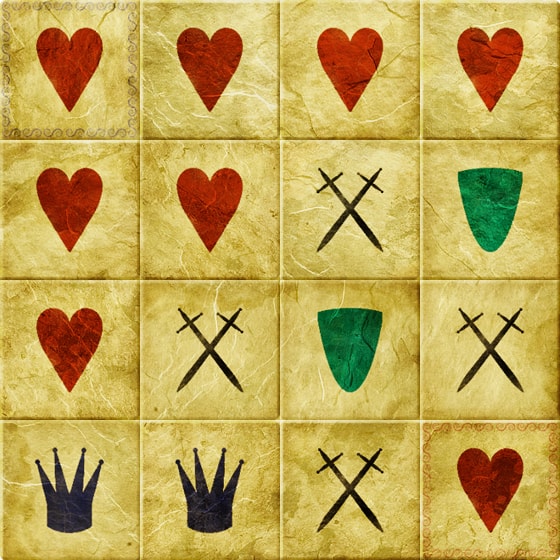
They must cross the floor from the upper left corner to the lower left corner. But the catch is that they are only allowed moves that match the tile they are standing on. If they manage to jump from one tile to the next following exactly the correct pattern, the door will open, a portal opens, or whatever you as a DM determine happens.
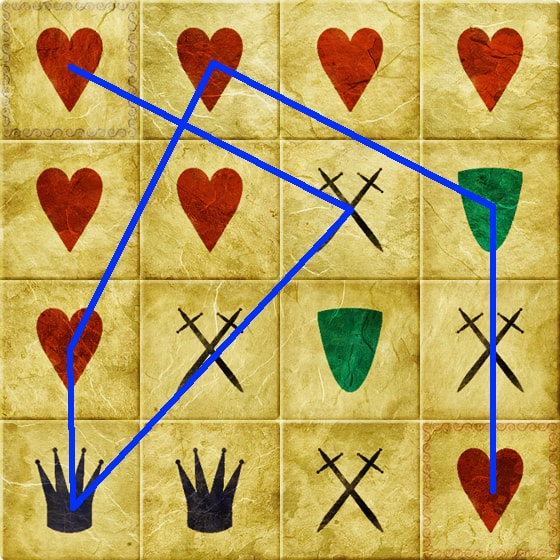
Feedback on this puzzle was that players felt it was a unique part of their world. The puzzle had meaning because it added a bit of halfling lore to the story. And since they were in a dungeon built by halfling it made sense to find a halfling puzzle there. Having to hop from one tile to the other like a skittish halfling added an extra challenge and gave players a change to use their ability scores. They also enjoyed the cooperative aspect of the puzzle.
- Enjoyment: 9
- Immersion: 10
- Flow: 8
Now you might be thinking: Sure Paul, you ran an “experiment” and the puzzle YOU designed just happened to win? That’s biased! And you would be absolutely right. But in my defense my puzzle does require a lot more work to design. And I’ve been asking players what they like in puzzles for over a decade. So these results did not come as a surprise to me. I do like to test if players actually prefer what I create before I publish it. After all, that’s what D&D did with 5th edition and it’s become the bestselling edition of D&D because of it. That also means chucking designs that I think will work but fail at the table. And there have been plenty of those as well.
The final result
So what are the general lessons in chess puzzle creation?
Overall, adding more flow to your D&D chess puzzles – or any D&D puzzle really – by creating multiple steps is what players enjoy. But creating immersion by having the puzzle be part of the world and be relevant to the story is the most important factor. And a bit of artwork goes a long way. Our survey about the best D&D puzzles even shows players don’t like chess puzzles all that much if the chess pieces are showing. So putting in the extra effort to improve immersion can really help create a better experience.
Of course, creating immersive puzzles is also the most work. Luckily I did that work for you. The Vault Bundle contains hundreds of illustrated immersive puzzles for D&D. If you like puzzles but don’t want to spend days creating artwork, be sure to check it out.
